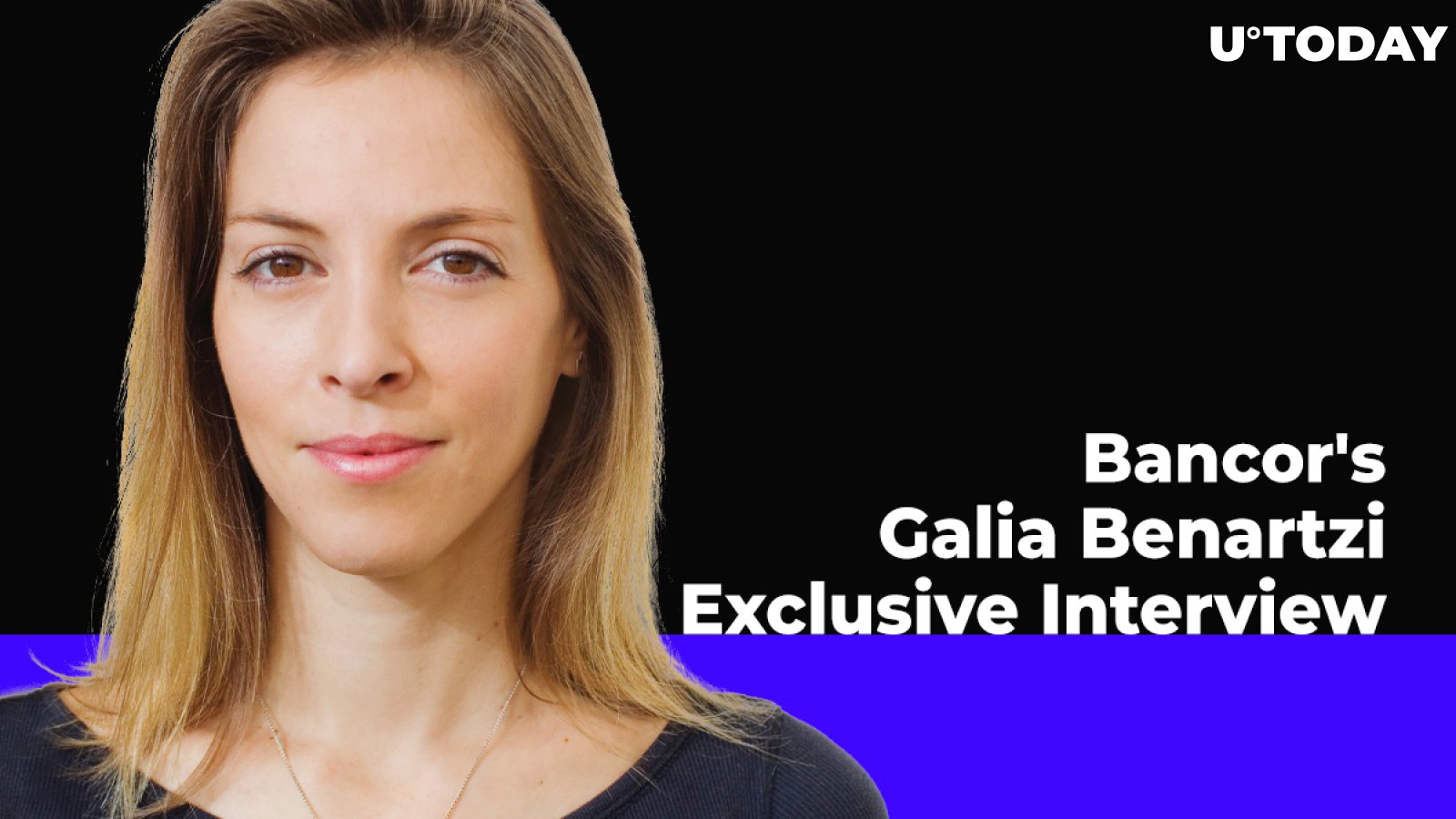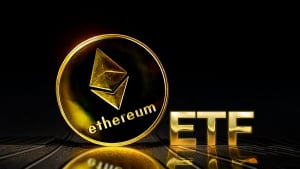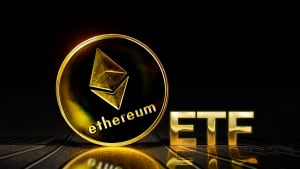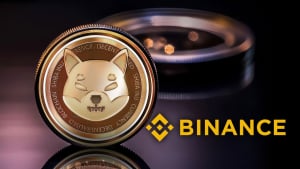A few weeks ago, I spoke with Galia Benartzi, the co-founder of Bancor—the company that is famous for the largest ICO in history. Galia told me about Bancor’s new update, what makes it special and why it is important for the industry. We also discussed what the next wave after DeFi tokens might be and what the future of blockchain will look like. Don’t miss this piece!
U.Today: First of all, can you tell us what brought you to the world of blockchain technology? What was the crucial factor that made you interested in the topic? And can you tell us about your background a bit?
Galia Benartzi: Yeah, absolutely. I grew up in Silicon Valley, California, and I've been a technology entrepreneur for the last 15 years. My team and I have built software startups in the fields of gaming, user-generated content, cross-platform content development technology for application developers and community currencies not originally on the blockchain.
I would say that what brought us to turn our technology efforts toward blockchain was, for me, studying economics; in 2009 and 2010, I studied international economics through Johns Hopkins. It was the time of the housing crisis or, rather, the financial crisis. It was a housing and a financial crisis in the U.S. and a euro crisis in Europe.
It was like I was in school for economics while all the economic systems were essentially breaking down or, at least, encountering crashes. That really got me thinking about going to the systemic level.
When I discovered Bitcoin, it was like opening a window in a dark room and a beam of light comes in—because so much of the challenge with international monetary stability seemed to be monetary policy, whether it was overissuance or currency handling. Bitcoin really offered the possibility to conceive of currency in a new way. It's not just the fixed monetary policy or the resistance to inflation. It's also the decentralized control. By this, I mean that, first of all, the currency wasn't issued by a government, and it wasn't controlled by a government. Many people see Bitcoin as a solution.
In fact, now 10 or 12 years later, we have thousands of cryptocurrencies and, really, the industry is just getting started. Our background in consumer internet and consumer technologies had exposed us to a phenomenon called the long tail, which is a theory that is very popular with internet applications. It says that when you lower the barriers to entry, when you make technology or applications or products accessible to everyone, you will get a long tail of activity. This means there will be parts of it that everyone will use, but there will be infinite niche versions.
On YouTube, you have the top 100 videos that everyone has seen, but after that you have hundreds of millions of videos that maybe only a few people have seen. But that's what's the most interesting thing about the long tail theory. It means that not the most popular titles or videos or products, but all the rest combined, have more volume in them, whether that's views or purchases or clicks or reads, than the most popular—what's called the head, or the top 10 or the top 100. It means that, for example on YouTube, most of the traffic comes from all of those videos you've never heard of or never seen—not from the top 10 that you and me and everyone we know has all seen.
When you apply this theory to currency, like we did at the time when we discovered Bitcoin, the idea was that we have these top currencies that are used globally, be it the dollar, the euro, the yen and others. But in a world where we reduce the technological barriers to creating a currency such as Bitcoin…
What thousands of teams have done in 10 years, perhaps another 10 years from now, millions of teams will have done. The long tail of currency—all of those currencies you've never heard of, so maybe not Bitcoin or Ethereum, but the thousands that will come later—those currencies have the potential together to encompass more volume. In currency, of course, volume means transactions and usage and economic collaboration. They have the potential to encompass more value than the top currencies we all know.
And if we take it back to what moves me the most and what moves the team the most, it really is this idea of a multicurrency world. It is the idea that freedom of currency, freedom of collaboration using any currency is a human right—the way that we now conceive of freedom of religion or freedom of speech or freedom of expression. In some places we're further along on freedom of assembly and other freedoms that we consider to be self-evident. We consider freedom of currency to be evident, but it's increasingly becoming self-evident in the wider world as well.
U.Today: But there is something bad about those thousands of projects. I mean, there are a lot of exit scam projects. How can people avoid these projects? Maybe you could give some advice to our readers that will help them protect themselves.
Galia Benartzi: I think the phase that we're in right now with the cryptocurrency industry is a very early and new phase. We know from every other type of market that is brand new, and from every other type of technology that is new, that at the beginning especially it can be very vulnerable to opportunism. The rules aren't clear. It's as if you're in the market for a new kind of stem cell product or a new kind of cybersecurity product. If the market is new, there's a good chance that there's still a lot of uncertainty and volatility in the market. So that's kind of a general disclaimer.
You can think of every currency out there like a product—just like a product that's listed on Amazon. By the way, we see more and more that Amazon is having difficulty authenticating products, making sure they get to the customers, making sure they're of the stated quality, etc. But if you think of a currency like a product, then you need to do the same kind of research on these currencies that you would do if you were buying a product for your home. That can mean one of a few things.
It can mean reading reviews. It can mean talking to other customers, whether it's online or in person—to other holders of that currency—or doing research on the company or the team. It is really a matter of looking into it, who's behind it. What's their motivation? Why are they doing it? Is there cross-referenceable evidence across the internet for the creators of the project and their motivations?
For example, when we launched Bancor, we went all around the world and gave speeches and lectures and AMAs, and a variety of media opportunities allowed us to create a breadcrumb trail, or an anthology of statements. It would have been possible to find the bios of every one of the founders to cross-reference that with the companies that we've worked in and for and the investors who have supported us in the past.
I think there's another element here that's very misunderstood and important for consumers, or rather users of these protocols, to understand. Even the best-intentioned teams, which are by no means being willfully fraudulent or creating exit scams, as you called them, are still dealing with very new ideas, very new technologies, very new operational landscapes—whether it's regulation, legal training, technical training or communication about very new topics.
It's important to me, especially, but also to the industry at large, that we differentiate between a falling token price and a fraudulent exit scam.
There are other outlier events, like a technical breach or a security hack or things like that, which may not be due to any negligence or fraudulence but are part of being involved in a very early stage of a very new ecosystem.
U.Today: Smart contracts have been successfully deployed to the Ethereum mainnet. As you told me before, when I first got in touch with you about a month ago, this was Bancor's biggest update in three years. Can you tell us in the simplest possible language what's new about Bancor V2 and what makes it different from the previous version?
Galia Benartzi: Yes. Like you said, Bancor V2 is the biggest update that we've pushed in the three years that we've been live, and it will remain in beta until later this Fall when the complete road tested version is pushed. Bancor's one of the most active teams in terms of CodeCommit and development of smart contracts. V2 really is the culmination of everything that we've learned in the past three years. It's important to reiterate that Bancor invented the automated market maker. The Bancor protocol was, for a long time, the first and only automated market maker in existence. It was certainly the first one on blockchain, the first one on Ethereum, the first one to have a protocol token such as BNT. The automated market maker space really is the cornerstone of DeFi.
You cannot have decentralized finance without automated market makers. Bancor really pioneered this invention in 2017 when we launched. Automated market makers are not one small thing. It's not one smart contract. It's not one piece of code. It's a very rich world, a spectrum of sophistication. With the original Bancor we launched the MVP, if you will—the basic fundamental automated market maker—a kind of gold standard or baseline formula that calculates prices between tokens. That's been running for the last three years now.
The fundamental thing that is new about Bancor V2 is the sophistication and dynamism of the smart contract, meaning that the Bancor protocol in its second version has become much more customizable. Because of this, it is much more able to optimize different use cases. And I'll explain a few of them, but the meta story of Bancor V2 is everything we have learned in three years as to how the idea or the theory of an automated market maker, which we launched in 2017, actually unfolds in practice in the field with billions of dollars of live token conversions.
The first major change in V2 is the ability to have single token exposure, meaning 100 percent exposure to a single asset. In the original version of Bancor—and also of forks and clones of Bancor, like Uniswap and others—you needed to supply both tokens, both sides of a token relay or liquidity pool, in order to participate in the protocol. That meant that, if I wanted to supply my Ethereum liquidity to the Bancor protocol, I needed to supply both Ethereum and BNT, the Bancor network token, in order to participate. The same goes for any other token; you would need two in order to participate. Not necessarily BNT, but others.
But V2 allows a user who is not necessarily a trader with a large portfolio of tokens, someone who just has a token that they would like to either swap for another token or supply as liquidity to the protocol, in order to a) participate and b) gain fees and rewards and various opportunities that come from being a liquidity provider.
Now a user can supply one single token and participate in the protocol as liquidity providers. That's a major change, and it majorly simplifies participation in a liquidity pool or in a liquidity network, with our eyes forward toward the more mainstream user as time goes on. That's number one: single token exposure.
Number two—and this is a huge one in the industry that for many years went undiscussed but was a real issue bubbling under the surface—is impermanent loss mitigation. Impermanent loss is the phenomenon of supplying two tokens to a liquidity pool. Like I mentioned, you had until now to supply two tokens. Because both of those tokens are changing in price all the time, even if you are accumulating fees by supplying liquidity to the network, you may actually be losing more than you're earning because of movements in the prices of those tokens. Maybe one is going up, but if the other one is not going up as fast, you're experiencing a relative loss of your treasury. The token that is gaining in price is being converted to the one that is losing in price in order to keep your liquidity pool balance. Thus, as prices are moving, you're sort of doubling down on tokens with falling prices, as opposed to tokens with rising prices.
Therefore, in your net net, if you will, you are often erasing all of the gains that you might have in fees by participating in the network as a liquidity provider. Often, you're actually losing much more than that. For years in the industry, fees and gains would be reported without calculation of this impermanent loss. The reason it's called impermanent is that it is on paper, or on blockchain, until you withdraw your tokens.
So as long as you're staying in the liquidity pool, watching these losses accumulate, you might undo those losses as prices change back in your favor. But as we know, oftentimes when folks are experiencing loss and seeing loss in their assets, they withdraw their assets—even at a loss, in order to prevent potential further loss.
What started as an impermanent loss becomes a very permanent loss to many, many users. This phenomenon has, of course, restricted the ability of automated market makers, liquidity pools and decentralized exchanges to become more and more popular with mainstream users. More and more usable. More and more safe. That's something that we took on very seriously in V2, the issue of mitigating impermanent loss. Again, this gets done on the smart contract side, on the formula side, in terms of how Bancor balances a given liquidity pool and the assets that our user is contributing to the network or to the protocol—how they are balanced and maintained by the smart contract and with what ends in mind.
Like I said, originally, the end in mind of Bancor V1 was to have a balancing smart contract that is creating automated pricing at every level for any token that's part of the network. Now, three years later, that goal is not only achieved, but exceeded beyond our wildest imagination in the sense that the entire DeFi industry is built upon this invention. It really is the cornerstone, the building block for such a wide and growing variety of decentralized finance applications.
However, that original goal is now history, and the next goal becomes further improvement and optimization of the experience so that it can be truly usable for more and more people, especially as the industry matures and brings in more mainstream users. Mitigating impermanent loss really is the second big innovation in Bancor V2.
The mitigation of impermanent loss and the single token exposure are really the areas where three years of being live with Bancor V1 gave us the most insight into the nearest-term challenges or obstacles for users in being successful with these products. There are many other upgrades and features in V2, but those are kind of the big topics and the ones users are struggling most with in DeFi today. For example, some that I haven't mentioned are the UX on the front end, and the way that people actually interact with the protocol on their computers or in their wallets.
Bancor V2 really takes us to the next generation of more sophisticated automated market makers that are more dynamic, more customizable and take into account the real use cases and experience that we've seen token providers and token swappers actually encounter. This is somewhat of a different endeavor than the original endeavor, which was to invent the automated market maker, build the proof of concept, launch it successfully on the blockchain and start attracting significant billions of dollars worth of liquidity into the protocol.
And as I said before, Bancor V2 is still in beta with a final full release scheduled for this Fall. So stay tuned for iterations and more features as this upgrade gains mileage in the field.
U.Today: That is very interesting. Thank you so much for such a detailed answer. Which DeFi projects do you find most interesting and why, and what should we expect from the DeFi market, in your opinion?
Galia Benartzi: Right now, DeFi is in a real renaissance. What's interesting to me as part of the 2017 renaissance, which was the token launch phase on Ethereum, is that people's memory seems to be very short. So many of the challenges that we encountered in 2017, both in terms of perception and real engineering-level challenges, were at the time called exit scams.
Now, in 2020, we have this sort of renewed ability to build more and more sophisticated products. At the same time, we have more people interested in crypto or familiar with crypto and using and playing with these products. We have more investors, more capital. We hear a lot about exit scams and fraud, and certainly those things exist. But what's really interesting to me is that out of the frenzy of activity in 2017 emerged the kinds of projects and products that allow 2020 to happen. Y
ou wouldn't have DeFi now without Bancor in 2017. You wouldn't have Bancor in 2017 without a flurry of activity on Ethereum that allowed us to build and launch a product and a project in that way.
You likely wouldn't have Ethereum without the flurry of activity around Bitcoin, in the years 2008 to 2013, when Ethereum was taking its inspiration and beginning toward its build. The interesting reflection for me, and for many of us currently, is that in all of the frenzy of 2020 DeFi, the fundamental infrastructure is being built upon which the next renaissance will be built.
U.Today: Bancor is one of a few projects that were part of the waves of both ICO and DeFi. So, you know what they are like from the inside. What will the next wave after DeFi be like in your opinion?
Galia Benartzi: If not next, one of the next areas for blockchain is consumer applications. You could say DeFi is a consumer application because finance is ultimately relevant to many, many people. But I think in its current form, no one would call DeFi a consumer market. It is for technology experts, for traders, for financiers.
However, there is a future wave of activity on blockchain, which really is utilizing the benefits of blockchain for all kinds of consumer applications, whether that's in the sharing economy, governance of communities, bootstrapping new networks, social media networks or communication networks, and those waves will be enabled partly by the wave that we're in now, by the DeFi wave. We're following the space very closely.
There's a ton of incredible products and projects and teams and ideas. What's really interesting from my perspective, sitting on the Bancor side of the table, is the ease of forks and clones in the space and what that means for teams in terms of needing to deliver real and lasting value and in terms of the kinds of teams that will play in the space.
For example, Bancor spent three full years developing the idea of why intra-token liquidity was important, and then how to solve it in a blockchain context with an automated market maker. It was a tremendous amount of effort. You also mentioned in your questions the token launch itself and the significant resources that it attracted. All of that is needed when you're going from nothing to something, at least in the AMM space. Fast forward from our launch to a year or a few years later, and you see projects like Kyber, like Uniswap, taking the Bancor blueprint, making changes, making optimizations, making customizations based on their ideas and their target markets and their target use cases. Those incremental improvements are much easier to make in a sense because they benefit from the original invention, and it is very hard to quantify the price it costs to invent something.
Fast forward from Uniswap a few years later, and you see SushiSwap and the interesting dynamics around being able to fork not only a protocol, but a protocol's entire liquidity or user base. On the one hand that creates frustrating and anxiety-inducing dynamics for teams and for users as well, I'm sure, who are invested in the success of these projects. On the other hand, it's exactly the openness that we all claim to be driving toward, right?
It is the benefit of setting users free and not locking them in. I think our space is experiencing a current subconscious level of negotiation with itself regarding how we want to see the evolution. Do we want it to be the most opportunistic evolution in the sense of a race to the bottom, if you can do something that someone else did, but cheaper, better, with some new mechanism—is that the direction? Do we want more distribution of our efforts so that, rather than creating incremental improvements on the same products, we create more products, new products, or we join forces with existing products?
There's no right answer here, but I think that what's interesting for token teams and ultimately for users of these products is that real value will have to be created and constantly recreated in order for projects and teams to be successful. Ultimately, that's a good thing for the industry, and that's a good thing for users.
U.Today: Thank you so much, it was incredibly interesting talking with you. I wish you success in all of your projects and have a great week ahead!
Galia Benartzi: Thank you for having me, Rimma.










